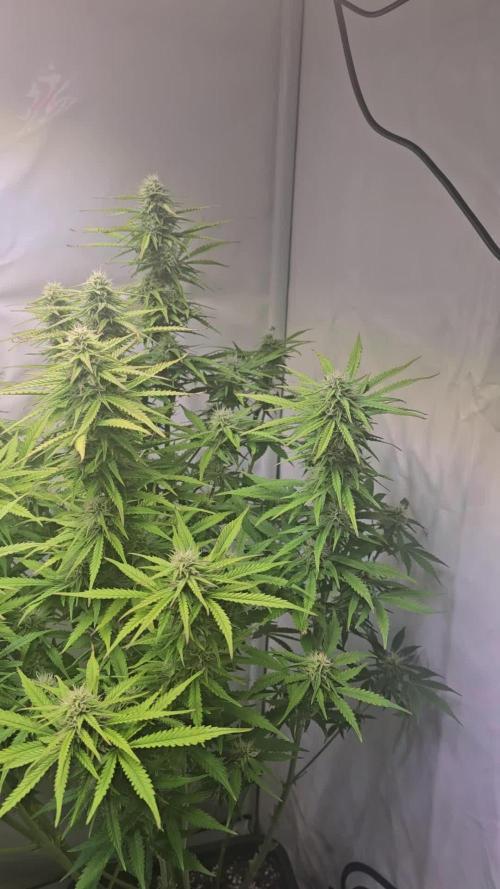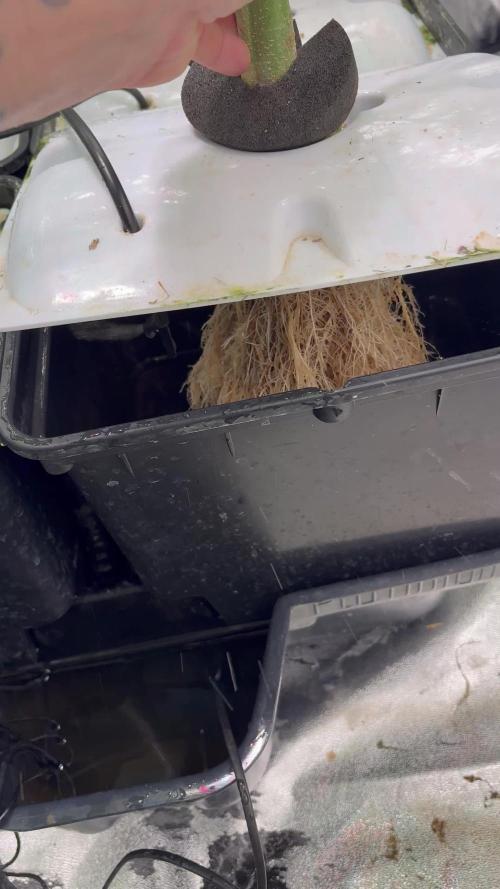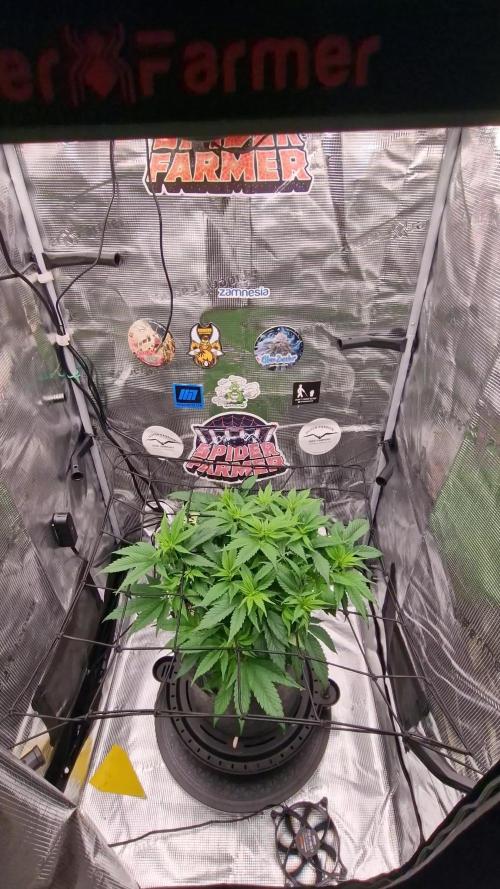The Grow Awards 2026 🏆 





































Likes
Comments
Share


@tangie
Follow
She's doing well as far as I'm concerned. Very late flowering, bud growth has almost stopped save for a couple smaller buds about the size of a plum each.
Pistils are turning from pure white to bright orange with cognac tones. I like bright orange hair in my bud, so I'm happy with this.
No less happy I am that I have apparently grown a significantly purple-ish plant, which would be my first time ever having access to purple-ish quality bud. I'm very excited to see how she turns out after curing!
Likes
15
Share


@Bluemels
Follow
An Tag 39 zeigt die Triple G eine winzige Vorblüte 😜
An Tag 40 habe ich die Triple G an 4 Zweigen getoppt.
Likes
11
Share


@ThatsmyGrow
Follow
Idk like how she turn the last weeks, its like she need more nutrients but i dont get it, maybe to soon 100% from the sanlights.
Likes
14
Share


@MrWigglyJiggly
Follow
What a journey this has been. This girl weighs(dry) 263grams plus 23 grams(untrimmed lower nugs) could have pulled out 350g if let her veg a bit longer. The taste is like sweet candy and soda a hint of citrus. The effects are as follows, creative, giggles and energetic but once its nearly gone out. You will feel really sleepy and when you wake up you will feel really hungry. Anyways, thank you guys who have been following my journey. Next grow will be seeds from Sunkentreasure seeds
Likes
26
Share


@TheWeedaltor
Follow
3 girls of the same family, eating same food, sleeping under same roof but running at different speeds 💚💚💚
Likes
36
Share


@nonick123
Follow
Día 122 (30/09) Riego con 750 / 1.000 ml H2O de osmosis
Día 123 (01/10) Riego con 750 / 1.000 ml H2O de osmosis
OnionOG #1 huele cada vez más a tierra húmeda, y sus cogollos son duros como pelotas de golf! ⚾
Día 124 (02/10) Riego con 500 / 1.000 ml H2O de osmosis
Hace 35 ºC de temperatura ambiente! Que barbaridad!
Día 125 (03/10) Riego con 750 / 1.000 ml H2O de osmosis
Hoy bajan las temperaturas 25-26 ºC, más normal para estas fechas
Día 126 (04/10) Riego con 750 / 1.000 ml H2O de osmosis
Día 127 (05/10) Riego con 750 / 1.000 ml H2O de osmosis
Las plantas empiezan a doblar sus ramas por el peso de los cogollos! 💪 🚀
Les aporto sujeción con cañas de bambú y cables de sujeción
Día 128 (06/10) Riego con 1 / 1,25 litro H2O pH 6,5 + Kelp Hidrolizado 0,3 g/L
Locura de día con 37 ºC y un aire caliente asfixiante!
💦Nutrients by Lurpe Solutions - www.lurpenaturalsolutions.com
🌱Substrate PRO-MIX HP BACILLUS + MYCORRHIZAE - www.pthorticulture.com/en/products/pro-mix-hp-biostimulant-plus-mycorrhizae
Likes
5
Share


@Satax
Follow
Everything is still going well overall. I’ve always had an issue with a Cal/Mag deficiency that I had to monitor for some of the plants. Otherwise, they’re swelling nicely — the Green Poison is starting to look really good and is showing signs of maturity, earlier than the others. I’m starting the flush on all the plants since I’ve fed them well during the grow, and I think they still have enough nutrients left in their systems.
The smell is very strong, and the buds are dense and resinous — it’s looking promising..
I’m going to start applying my stress technique on the plants by inserting screws into the stems and using a small scalpel to remove some bark along the trunks, in order to push the resin production even further.
Likes
9
Share


@Gerard_1
Follow
Germino cerca de navidad pasada con muchas expectativas de este cruce las cuales ha cumplido muy bien, sabores muy ricos dulces, resistente a métodos de stress y trasplantes, se muestra en fotos tamaño de brotes compactos y carnosos, se pesa solo brotes sin ramas solo necesarias
Likes
6
Share


@kevxyn
Follow
Let’s go 🔥🔥🔥
Lampe auf 12/12 bei 60% 💡
Der Wassertank ist wieder am Start! 🌊 Sie scheint es jetzt viel besser zu vertragen. Gegossen wird nur noch ganz dezent, um die Living Soil im oberen Bereich leicht feucht zu halten. Ab und zu gibt’s ein bisschen Komposttee – alles andere holt sie sich direkt aus der Erde. 🌱
Blüte seit dem 5.11 am Start und bisher läuft alles nach Plan 😎🍁
Likes
101
Share


@Ferenc
Follow
Day 58, 11th of November 2020:
I set the lamp 15 minutes shorter to switch off earlier so they receive 11:45 of darkness. I would like to imitate the nature when longer nights come with time till the 4th week (when they will receive 13 hours darkness a day 15 minutes minus 4 times = 1hour) so every week 15 min longer darkness for 4 weeks and then back to 12/12 to have bigger buds from the 4th week....
Wao. Well, all good hopefully they will stop growing soon but the strech is not that much thanks for the trainings such as topping and LST....
Pistils are started appearing so they she the sex I think one more week to go and they will settle down concentrating on bud development.
What to say every 2nd day is fertilization with the mix and ratio above now we are waiting.
Anything else? Well just look atbthe pictures and decide what you think. I am pretty sure they look cool LOL.
This Gleato Zamnesia is very promising I really like the smell already she is nice but all of them I mean I am in love with all so. Kalinia Asia is nice and I am so excited for the Sweed Seeds ones the red girls OMG :)
Likes
3
Share


@KcKush
Follow
*Increaded PPM to 650
*Last plant showed sex it’s s Female. Looked like a male almost chopped it.
*We Can say we got a 60% female return.
*These are ready to flower but need to take clones first.
Likes
16
Share


@CityFarmer
Follow
Hello everyone,
Well its getting kinda packed in the greenhouse so all i have for you guys is a little video,
See you guys next week... 🤘🤘🤙🤙
Likes
6
Share


@Chubbs
Follow
420Fastbuds
FBT2302 Week 8
What up everyone. Hope all are having an amazing weekend. Weekly update for these two. The frosty one seems to be just getting more and more frosty. The others not to far behind flowers are starting to frost up so one can only hope it turns out the same. I'll probably do a mild defoliation this week taking off some of the bigger fan leafs. Will keep the same routine as the plants seem to like it and are responding well. All in all Happy Growing
Likes
10
Share


@Budhunter
Follow
Day 69 of cycle - day 32 of flowering.. My biggest plant in size since I started growing 3 years ago.. I qm really happy with what is coming out of this besuty gelato.. I am impressed by the growth and health of this babe.. many branch sides with many top buds.. the smell is amazing, that good gelato we all know.. let’s fatten it up and I can’t wait to smoke it.. let’s go
Likes
46
Share


@DogDoctorOfficial
Follow
Hello, green warriors and cannabis enthusiasts! 🌱🔥 We’re now in the 4th week of flowering in our epic Runtz Battle, and things are getting intense! This week was a major milestone as we performed a deep, mass defoliation to set the stage for the final push toward harvest. Let’s dive into the details and explore the impact of this crucial step.
Week 4 Flowering Progress 🌿🌟
Our Runtz plants are thriving as they enter the second half of the flowering phase. Here’s what’s been happening:
• Bud Development 🌸:
• The buds are swelling beautifully, with trichome production ramping up across all plants. The flowers are becoming increasingly dense and aromatic, promising a rich and flavorful harvest. The F1 strain continues to stand out with its compact, resin-packed buds that are now truly taking shape.
• Environmental Consistency 🌡️:
• We’ve kept the environment stable with a room temperature of 30.3°C, water temperature at 18°C, and humidity at 51%. These conditions are ideal for promoting healthy flowering and preventing any issues as the buds continue to bulk up.
The Power of Defoliation 🌿✂️
This week, we carried out a deep, mass defoliation—an essential practice for optimizing bud production. Let’s break down what defoliation is and why it’s so important at this stage:
• What is Defoliation? 🌱✂️:
• Defoliation involves selectively removing a significant amount of fan leaves from the plants. This process is particularly beneficial during the flowering stage as it allows better light penetration and air circulation to the lower bud sites.
• Why Defoliation Matters 🌟:
• Light Penetration: By removing excess foliage, we’re ensuring that light can reach deeper into the canopy. This light exposure helps to stimulate growth in the lower buds, leading to a more uniform and higher-quality yield across the entire plant.
• Air Circulation: Better airflow reduces the risk of mold and mildew, especially as the buds become denser and more susceptible to moisture-related issues.
• Energy Focus: Removing large fan leaves redirects the plant’s energy from maintaining foliage to developing the buds. This means the plants can put more effort into producing larger, more resinous flowers.
• How the Runtz Plants Responded 🌸:
• The Runtz strains handled the defoliation like champions! They’ve already begun responding positively, with the remaining leaves and buds soaking up the extra light and air. We’re expecting to see even more vigorous bud development in the coming weeks as a result of this defoliation.
Nutrient and Care Strategy 🌱💧
Our nutrient and care approach continues to support the plants as they push through this critical flowering stage:
• Watering and Nutrients 💧:
• With the Autopots still running smoothly, we’re maintaining the Regulator and CaMg Boost in the reservoir. The rich soil, bolstered by organic inputs, is providing all the necessary nutrients to sustain healthy growth and flower production.
• The defoliation has also allowed us to closely inspect the plants, ensuring they’re free from pests and diseases and making any necessary adjustments to the care routine.
• Lighting and Environmental Control 🌡️:
• The Lumatek Zeus 465 Compact Pro continues to deliver powerful, even light, now reaching even more of the plants thanks to the defoliation.
• The TrolMaster Hydro-X controller is keeping everything dialed in, maintaining the perfect environment for the Runtz strains to thrive.
The Zamnesia Gear Shines 🌟📸
We captured some amazing photos this week, showcasing the defoliation process and our beautiful Runtz plants. Shoutout to the incredible gear from Zamnesia that makes this journey even more enjoyable. Their products not only perform exceptionally well but also look fantastic in action! 🌿📸
Looking Ahead 🌟🌿
As we move into the latter stages of flowering, we’re expecting some serious bud development. The defoliation has set the stage for the Runtz strains to focus all their energy on creating dense, resinous flowers. The next few weeks are going to be critical as we fine-tune the environment and prepare for the final push towards harvest.
Stay tuned for more updates as we continue this thrilling journey. The finish line is in sight, and the anticipation is building! 🌟💚
#RuntzBattle #Week4Flower #CannabisCommunity #DefoliationDay #BudDevelopment #GreenMagic #ZamnesiaGear #LumatekZeus #TrolMasterHydroX #GrowStrong #StayPositive
Germination method 🌱 @thecannakan
Genetics Runtz F1 @zam.nesia Runtz auto @kannabiaglobal
Nutrition
@aptusholland 🌿
@aptus_world 🌎
@aptus_es 🌍
@aptusbrasil 🌱
@aptus_thailand 🌿
@aptus_portugal 🌳
@aptususa_official 🍀
@aptusplanttechnz 🌺
@aptusplanttechaus 🍃
Ambient controls🎮
@trolmaster.eu @trolmaster.eu.support @trolmaster.support @trolmaster.agro
Soil @promix_growers_eur @promix_cannabis
LED - @lumatekeu
Watering- @autopot_usa @autopot_global
Love and attention- @dogdoctorofficial
#aptus #aptusplanttech #aptusgang #aptusfamily #aptustrueplantscience #inbalancewithnature #trolmaster #trolmastereurope #trolmastersecrets #Autopots #RuntzBattle #KannabiaVsZamnesia #GreenJoy
As always thank you all for stopping by, for the love and for it all , this journey of mine wold just not be the same without you guys, the love and support is very much appreciated and i fell honored and so joyful with you all in my life 🙏
With true love comes happiness 💚🙏 Always believe in your self and always do things expecting nothing and with an open heart , be a giver and the universe will give back to you in ways you could not even imagine so 💚
More info and complete updates from all my adventures can be found ⬆️ link in the profile description ⬆️
Friendly reminder all you see here is pure research and for educational purposes only
💚Growers Love To you All 💚
Processing
Likes
14
Share


@TegridyCal
Follow
The Pineapple Express was born and continues to grow regularly. It does not stand out for its speed but it will certainly be worthy of remembering the mythological strain.
Likes
30
Share


@BudXs
Follow
Oh it was a special week. Day 21 of flower marks the Silver Back Guerilla defoliation day!!!!
I left one be. For him. To prove me wrong. BUT!!! That one had some dead leaves at the bottom that needed removal, not the defoliated plants!!
Time will tell as to if what Im doing is right. I stick to my guns that this works for my room. Even though I read differently, removal of foliage has lowered my rh. Could very well be outside environment, however.
By day 21F the room was a bush again. In my opinion, it needed the heavy defo to breathe. As for light penetration, I am extremely happy with the amount of heads receiving direct light. Im a pig in shit
Thanks for looking, I dont want to hear your opinion on defo or schawazze, unless youre SBG
Likes
21
Share


@Felloffthegrid420
Follow
Welp I just Doubled up on my feed bc last week seem to not hurt feed more this is my last time feed rain water for here on out I’m let pots dry out a lot the start giving hell of water I’m think be done in the next two week a lot can be done in two week keep my finger crossed I’m ready clip some this fire up jar up and smoke it this all was hardest time for me this is day 100 from seed day 46 of flower
Likes
40
Share


@valiotoro
Follow
Brocoli buds!🥦
Super sticky & delicious smell its just sweet🤤
When you smell the amnesia Z she seems to be kind but trust me roller coaster effect !🎢


















